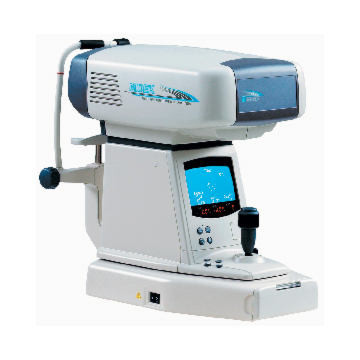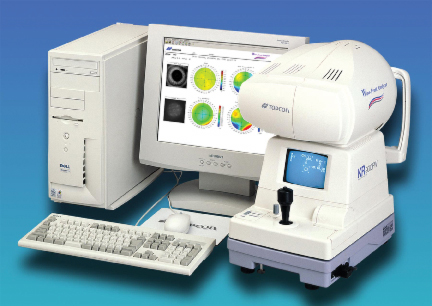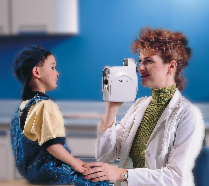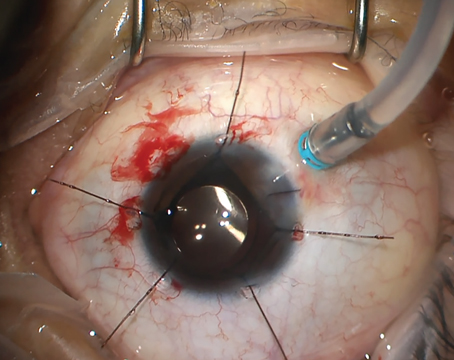The final installment in Review's "In Practice" series, this article reviews the efficiency boost of autorefractors and takes a look at these machines' added potential thanks to wavefront technology.
The Advantages
Using an autorefractor is quick and easy compared to the time-consuming practice of retinoscopy and baseline refraction. The resulting reading still requires professional subjective interpretation, but "it gives you a place to start," says Douglas K. Grayson, MD, FACS, of Omni Eye Services in New York. "If I were refracting people all day in this office, I'd be putting them on the autorefractor first and then in the phoropter for refinements, mostly for the time savings," he says.
The autorefractor is an alternative to the retinoscope/phoropter combination, says Topcon product manager Steve Hamilton, but he does acknowledge that the classic pieces of equipment still come in handy. "The retinoscope will show some pathology that the doctors will sometimes like to see," he says. "But in most cases, an ophthalmic technician is doing the workup and is unable to use a retinoscope effectively." So, he says, the autorefractor excels for speed and efficiency: "The autorefractor is a great tool for the technician to acquire that data."
Innovations

Marco's ARK730A adds the ability to perform keratometry readings.
Some autorefractors speed up the in-formation-gathering process even more by offering a data link to an auto-phoropter, or sending the readings directly into the patient's electronic medical record. Other models can accept subjective adjustments, eliminating the need to walk the patient to the manual phoropter to do the refinements.
Newer autorefractors feature fixation points that look like a house at the end of a road, a Christmas tree or a hot-air balloon—interesting things that can hold that patient's attention long enough to take the refractive reading. These targets make the test much easier for patients, says Houston ophthalmologist Jim Key: "On some of the older machines, they were looking at blur circles and fixation was difficult. Even children can do the new tests quite well."
Combination instruments (with keratometry or topography) provide three times the diagnostic capabilities in one machine. "Buying one unit that does all three things—refraction, keratometry and topography—takes up a lot less office space and creates operating efficiency; you're not moving the patient from one station to another," notes Topcon's Mr. Hamilton.
He relates that Topcon makes an autorefractor for a variety of practice situations, but that the most commonly requested model is the dual function autorefractor that includes keratometry. "When a physician selects the dual-function model, he typically has topography in the office already," continues Mr. Hamilton. "But if he doesn't have a topographer to begin with, or he's looking to re-place a set of outdated equipment, I tell him that, for best use of space and efficiency, a tri-function unit gives him the most for his money."
Mr. Hamilton reminds users that many autorefractors, including those from his company, offer an assortment of secondary measuring utilities. "If you utilize all the features on the instrument, you'll find a measurement tool for corneal diameter, which is handy for contact-lens fitting," he says. "There's imaging built in so you can freeze-frame to assess any corneal distortion." He adds that Topcon's tri-function model with topography can do some overlay maps and allow assessment with the placido rings for any corneal irregularities.
 |
| Topcon's KR9000PW autorefractor includes wavefront technology that will measure, record, analyze and display the visual aberrations of the patient's eye. |
Accuracy is up greatly too in the latest wave of autorefractors, according to Dr. Key. His office bought a new NIDEK autorefractor about three years ago, and he reports that, as long as the patient can fixate, the machine gives a good reading. He finds it especially accurate in determining the axis of the astigmatism.
Handhelds
The introduction of portable auto-refractors in 1995 broadened the range of patients on whom technicians could obtain quick readings. With the advent of handhelds, an autorefractor could be used on patients with certain disabilities, such as those who cannot hold their head up straight. Tech-nicians could position themselves to work on bedridden patients or those already prepped and lying down for surgery.
Handheld units have made testing easier on children, too. Welch-Allyn's Rick Farchione calls the SureSight child-friendly, and decidedly non-threatening because it is used from 14 inches away and has lights and sounds to engage the child. "But it's certainly not only for children," he says. "It's good for the disabled or for patients with a language barrier, because no patient response is necessary."
Mr. Farchione says that a handheld unit such as the SureSight is ideal for vision screenings with community groups or health fairs. Physicians who travel to volunteer in developing countries value the portable units. "We get a lot of requests from people doing mission work," he says.
The portable autorefractor is not only for use away from the office, cautions Mr. Farchione. "Space is always an issue in a physician's office," he says, "so we wanted to offer something that doesn't take up a whole table top." He calls a handheld a cost-effective alternative to a traditionally expensive desktop unit. Handheld units may be a good choice for a physician who needs to transport the machine between multiple offices.
While some voice concerns about operator-induced axis or cylinder with handheld units, Mr. Farchione thinks there's little reason for hesitation. "The SureSight is extremely easy to use and doesn't require a lot of manipulation to get a reading. The user does need to develop the proper technique to get consistent and accurate readings, but the machine does a lot of the work for you," he says. A tone beeps to indicate when you are the right distance from the pupil, he describes, and readings are taken in less than five seconds per eye. "You can take readings from more than a foot away. Once it beeps, all the user needs to do is keep it square, straight and level in front of the patient for just that short period of time."
Challenges
Dr. Key lists only a few circumstances where his autorefractor can't get a good reading. He says it will work through early cataracts, but a dense one will prevent a reading. "A disturbance in the media such as a vitreous hemorrhage will throw it off. Nuclear sclerosis beyond the 20/100 best-corrected level will prohibit an accurate reading, as will a posterior subcapsular cataract right in the center of the visual axis," he reports.
 |
| The handheld SureSight Vision Screener by Welch-Allyn makes testing kids easy. |
Laurie Spurgeon, COT, is on staff at Wallace Eye Surgery in Alexandria, La. She uses the autorefractor daily for just about everyone who steps through the door. Her routine workup is to test vision without correction, vision with the current prescription, manifest refraction and a glare test with their "older model" desktop auto-refractor. She too finds using the auto-refractor difficult on some patients, whom she will direct to the exam lane and the classic technology. She offers as an example patients who have such low vision that they are constantly searching to find the letters. "The machine can never get a reading be-cause of the head movement," she says. Besides keeping the head still, good positioning will lead to an accurate reading. "I've found that seniors sometimes have a hard time holding the position and tend to move back from the machine," she says. "So I gently remind them to keep their foreheads all the way forward and their chins down, so that the machine can get a reading."
Ms. Spurgeon has also learned the quirks of her machine and how to feel confident about the readings it puts out. For example, she knows that her autorefractor tends to give too much minus to a patient with a multifocal IOL. She's found that subtracting about 5 D will bring the reading right around the patient's actual prescription. "If I don't feel comfortable with the readings I am getting, I'll double-check the patient in an exam lane," she says.
The Next Wave
New autorefractors that offer wavefront technology will measure, record, analyze and display the visual aberrations of the patient's eye, adding at least a fourth diagnostic test to some ma-chines' capabilities.
According to Mr. Hamilton, Topcon manufactures a 9000 series of autorefractors that includes wavefront aberrometers. (The model 9000PW is currently available in the United States.) "I see wavefront technology as the next step in these machines. It will allow the physician to assess not only lower-order aberrations as he can now do with an autorefractor, but also produce higher-order aberration data," he says. He points out that a four-in-one machine equals even greater office operating efficiency.





